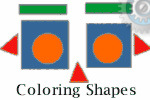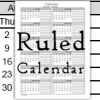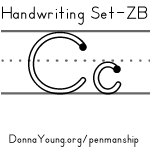Lab Report Terms and a Sample Lab Report
By Cheryl Randall
Scientists know that lab reports are a very important part of every experiment. The purpose of an experiment is to answer a question by testing a hypothesis. During an experiment you may collect a lot of information, or data. But that data is not very useful unless it is organized. The purpose of a lab report is to organize and communicate what you did in your experiment. A good lab report explains exactly what you have done. It can be used to repeat the experiment or to test other hypotheses in new experiments.
Lab Report Form
(Name)__________________ (Date)______________
Title: ______(the name of the lab or experiment)
Purpose/Problem:
The purpose or problem states the reason(s) why you are doing the experiment. Write down exactly the problem that will be investigated or experimented. Purposes can be stated as a question.
Introduction/Research:
In a few words tell what you already know or have found about the problem that will let you make an educated guess. This is your background information from the text, teacher, or other sources. It gives the reader an understanding of underlying principles and content information of the laboratory.
Introduction/Research:
What do you expect to find? The hypothesis can be stated as an "If..., then..." statement. The 'If' part of the statement is based on related facts that you know to be true. The 'then' part of the statement is an educated guess on the outcome of the experiment. The hypothesis does not have to guess the correct outcome, but the experiment must be set up to test the hypothesis.
Materials/Supplies:
This is a list of all equipment and chemicals used to do the experiment. Please include quantities (amounts).
Procedure:
The procedure tells exactly what you did. Make statements in the past tense. Be specific. The procedure you use affects the results. So, it is important to be accurate in explaining what you did. The procedure is written in paragraph form.
Observations and Data:
The observations tell exactly what happened when you did the lab. An observation is measurable information that comes to you through your senses. Results include experimental (raw) data in the form of well-labeled tables, graphs, drawings and other observations. Place your observations and data in this section without discussion or comment. This is where you include any calculations made during the experiment. Answer any questions here.
Conclusion/Summary:
Conclusions explain your observations and describe how your data relates to the problem. It is written in paragraph/essay form and should include why you did this experiment (restate the purpose/problem). You should explain in your own words what you found out or discovered. Your conclusion should state whether or not the data confirms or rejects your hypothesis. Discuss any errors as well as any patterns you see. Part of the conclusion may be a new hypothesis based on your findings and suggestions for testing the new hypothesis in a different experiment. You may also make any predictions you would expect based on what you discovered.
Sample ReportTyler Fleegenshneeze August 11, 2001 Title: Making a Seismograph Purpose: How does the magnitude of vibrations affect the amplitude of a seismograph? Hypothesis: An increase in the magnitude of vibrations will result in an increase in amplitude of the seismograph. Materials: clamp, metal bar, piece of string, rubber bands (2), table, pencil, two people Procedure: I laced a piece of paper directly beneath the pen and the clamp stand. One person slowly moved the paper past the pen, as the other hit the end of the table. The first trial represented a medium magnitude movement. The second trial was the soft movement, and the third was the hardest, or the most forceful magnitude. While looking at each individual seismograph, the greatest magnitude was observed and identified. Measuring the distance from the top and bottom of the spike represented the amplitude. The data from each seismograph was recorded in the table on the following page. | ||||||||||||
| ||||||||||||
| Conclusion: This lab investigated how the magnitude of vibrations affects the amplitude of a seismograph. In order to study the problem we created three magnitudes of movement and measured the amplitude of each with a seismograph. My results showed the trial with the greatest amplitude was trial three because the table was being hit with the most force, making the table and the pen move more than the other three trials. The trial with the least amplitude was trial two because the table was hit with the least amount of pressure. While observing the experiment, I noticed that the more vibrations or higher magnitude resulted in a higher amplitude on the seismograph. The harder the table was being hit, the higher the amplitude rose. This proves my hypothesis was correct. I believe the results are accurate because while the experiment was in progress, the frame moved at the same rate as the table. It was proven in trials one through three that the increased magnitude of table movement caused the greatest amplitude differences on the seismograph. It is clear, therefore, that the movement of the frame also corresponds to the amplitude of the seismograph. The bar and marker shared the same relationship with the table and the frame. The more the frame moved, the greater the amplitude on the seismograph. In order to further investigate this problem, next time I would try the experiment on a different surface and would add additional movements of varying forces for further readings on the seismograph. |
Lab Report Form
(Name)_____ (Date) _____
Title:
Purpose/Problem:
Introduction:
Hypothesis:
Materials/Supplies:
Procedure:
Observations and Data:
Conclusion/Summary:
This lab (experiment) investigated __________. In order to study the problem we ___________. My results showed ____________, thus proving my hypothesis was ____________. I believe the results are (accurate/inaccurate) because ____________. In order to further investigate this problem, next time I would _____________.
- Do draw a picture of the experiment, if appropriate.
- Dont say that the purpose was accomplished and then say nothing substantially more. You must include data from the lab results to demonstrate that the purpose was accomplished.
- Dont give the procedure again.
- Dont list the data again. It was already listed in the data (chart, table, etc.). You are to discuss and draw conclusions from the data.
- Dont forget to break up your ideas with more than one paragraph, if necessary. (This is referred to as an essay!)
- Co-op
Cheryl also suggests that the basic format suggested by Dr. Wile: Title, Date, Observations/Data, and Conclusion/Summary is adequate for 7th, 8th and 9th graders and the full format for documentation that she suggests above is optional.


 Donna added an English index
Donna added an English index  Planning Guide for AOP Art Electives, Unit 7 Comics
Planning Guide for AOP Art Electives, Unit 7 Comics Coloring Shapes
Coloring Shapes


